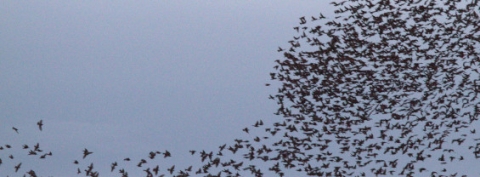Marginal speed confinement resolves the conflict between correlation and control in collective behaviour

How a bird’s individual speed is regulated within a flock, such as during murmurations, is modelled in a study published in Nature Communications.
The model could improve our understanding of collective dynamics in biological systems and may have implications for the development of swarming robotic devices. Empirical data show that the changes of velocity of individual birds within large flocks influence each other over large distances, and leads to collective displays such as murmurations. However, how birds regulate their speed within a group is not well understood.
Previous studies of collective bird dynamics have suggested linear models to describe internal speed control, but these do not simultaneously explain how birds can influence each other over long distances and also the limited group-to-group speed variability observed in biological data. Antonio Culla and colleagues developed a mathematical model with marginal speed control that takes into account differences in individual bird’s speed and flock sizes, and reproduces experimental traits of flocks ranging between 10 and 3,000 in group size (AU- is this correct?).
The authors analyzed individual trajectories of starlings extracted from videos of natural flocks and compared the observed dynamics with numerical simulations of an artificial flock. The model was then able to reproduce large-scale correlations with limited speed variability from flock to flock, which corresponded to the observed experimental data. The authors argue their model could aid our understanding of collective dynamics and internal mechanisms of regulation in biological systems, and potentially expand our knowledge beyond bird flocks.
They suggest that understanding how individual speed is regulated within a group could have practical applications in the field of robotics to enhance correlation and reduce large speed fluctuations in swarms of artificial units.
Contact: antonio.culla@sapienza.isc.cnr.it
Authors:
Andrea Cavagna, Antonio Culla, Xiao Feng, Irene Giardina, Tomas S. Grigera, Willow Kion-Crosby, Stefania Melillo, Giulia Pisegna, Lorena Postiglione & Pablo Villegas
Reference:
Nature Communications
